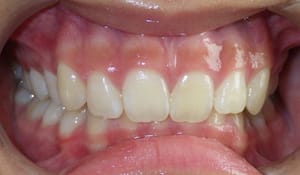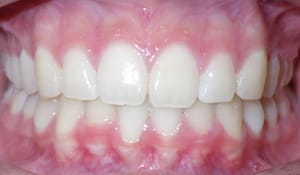Home - All About Braces - How to Know If You Need Braces - Deep Overbite

Erick practices orthodontics in our Riverton Oral Health office.
Deep Overbite
What a Deep Overbite Means, Why It Matters, and How Orthodontic Treatment Can Help.


A deep overbite occurs when the upper front teeth excessively overlap the lower front teeth, sometimes causing the lower teeth to bite into the roof of the mouth (palate). This isn’t just a cosmetic issue — deep overbites can lead to pain, premature tooth wear, and even injury to the soft tissue of the palate.
This type of bite problem is often hereditary, but it can also be caused or worsened by jaw growth patterns and childhood habits like thumb sucking or prolonged pacifier use.
What Causes a Deep Overbite?
Deep overbites typically result from a combination of skeletal and dental factors. These may include:
- Uneven jaw growth (especially a short lower jaw)
- Crowded or misaligned teeth
- Poor oral habits during early development
- Loss of back teeth (in adults), which alters bite balance
In growing children and teens, untreated overbites may worsen over time without orthodontic intervention.
Signs of a Deep Overbite
- The lower front teeth disappear behind the upper front teeth when biting
- The lower teeth make contact with the roof of the mouth
- There’s noticeable wear on the lower front teeth
- The chin appears recessed or “tucked in”
- There’s jaw soreness, tension, or popping
Why Treatment Is Important
- Gum damage and trauma to the palate
- Early wear or chipping of the lower teeth
- Jaw strain, headaches, or TMJ problems
- Bone loss or receding gums over time
How to Fix an Overbite
Treatment options may include:
- Braces with rubber bands to realign the bite
- Bite turbos or other appliances to separate the teeth during correction
- Tooth extraction (in rare, severe cases)
- Clear aligners for appropriate cases
For younger patients, early orthodontic monitoring can help reduce the severity of bite problems and simplify treatment later on.
When to Schedule a Consultation
If you notice your child’s lower teeth biting into the roof of their mouth — or if their upper front teeth seem to completely hide the bottom row — it’s time to schedule an orthodontic consultation.
At Families First, we offer complimentary consultations that include imaging and expert treatment recommendations from our orthodontic team. Learn more about the different types of braces that can help correct a deep overbite.
Claim Your Complimentary Consultation
Our orthodontic team is here to help with complimentary orthodontic consultations in Bluffdale, Riverton, Stansbury Park, and West Jordan.
Complete the form below or call (801) 254-9700 to schedule.